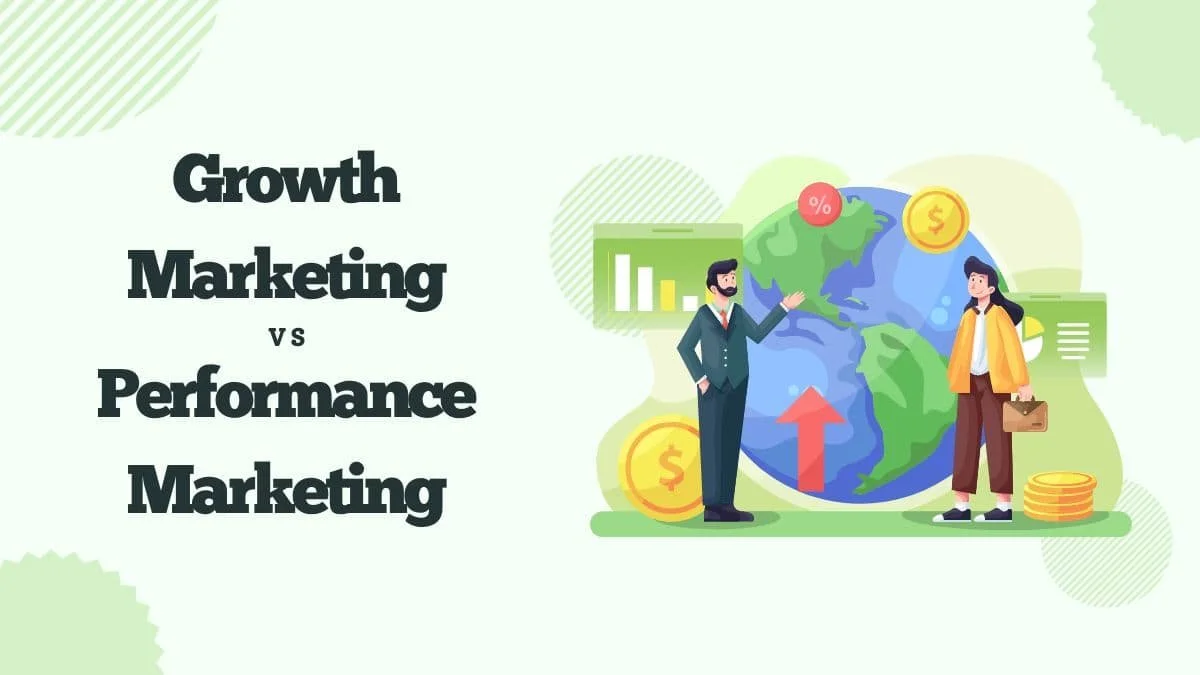Growth Marketing. Growth Hacking. Performance Marketing. Digital Marketing.
All of these are used interchangeably, and it causes so much confusion.
So here is a short summary of what growth marketing entails to set the record straight.
“Growth marketing is about optimizing your marketing efforts to match the entire customer journey. The goal of growth marketing is relatively simple: improved engagement and conversion metrics throughout the entire marketing funnel, from generating awareness to getting them to become paying customer and retaining them and upselling them with complementary products and services .
In essence, growth marketing is about acquiring prospects/users from the top of the funnel by making them aware all the way to retaining those prospects/users as entrenched customers.”
To be clear growth marketing tries to improve results throughout the entire customer purchasing journey funnel in a way that is both sustainable and long-term
Here are some other terms that are often confused with growth marketing, but are in reality clearly different and distinct.
Performance marketers: These specialists only work on paid channels, often paid social — on channels like Facebook Ads — and search engine marketing (SEM). They typically don't work with email, content, or other channels — whereas growth marketers will test out any channel.
Digital marketing: These marketers often lead the marketing function in small companies. As such, they are generalists — writing blog posts, sending customer emails, and running paid campaigns. They think holistically about the company and its growth but are far less data and metrics-driven than growth marketers.
Demand generation marketers: These are the closest to a growth marketer of these three options listed above. However, they typically focus more narrowly on top-of-funnel activity, like attracting leads and customers.
Traditional marketing focuses on the top of the funnel, often with activities that drive short-term wins.
But growth marketing, specifically, requires you to focus on the entire funnel. Growth marketers are data-driven pros who work tirelessly to find innovative ways to drive user acquisition, keep customers engaged, retain them, and ultimately turn them into brand champions.
In other words, growth marketers are master experimenters at every stage of the funnel. And they work closely with the whole business to gain better insights.
What are some of the core components of a Growth Marketing-based Approach?
A growth marketing strategy can be based on metrics including customer acquisition, conversion, retention, and lifetime value. Here are some of the leading tactics that today's growth marketers use to attract, convert, create, and retain engaged customers.
A/B Testing
A/B testing, as well as multivariate testing, is one of the core tactics and tenets of a strong growth marketing strategy. They can be used in a number of formats, including email marketing, landing pages, social media ads, and others. This involves deploying either an "A" and a "B" test, or a series of multiple tests, to understand which variation of your content (with customizations around graphics, copy, design, and other features) does a better job of engaging your audience and increasing your conversion rate. You can then optimize future marketing campaigns around that variation—continually iterating on your successes to enhance performance with every test.
Cross-Channel Marketing
Cross-channel marketing focuses on building a strategic channel plan to reach your customers. These can include email marketing, SMS messaging, push notifications, in-app messages, direct mail, and other channels, based on your audience’s preferences. When incorporating a cross-channel marketing plan into your growth marketing strategy, you need to focus on the individual user to understand their communication preferences, and build out your campaigns accordingly. For example, A/B testing can help you first understand that a particular user responds to push message offers at a 60% higher rate than email marketing offers. Knowing this allows you to customize future campaigns to focus on push offers.
Customer Lifecyle
A customer lifecycle is a journey your customers embark on as they learn about, interact with, buy or convert, and re-engage with your company. There are 3 critical lifecycle stages that growth marketers focus on: activation, nurture, and reactivation.
The activation stage is the initial stage of the lifecycle where companies seek to activate consumer attention and interest. Growth marketers target customers with welcome, onboarding, trials, and other introductory campaigns to build familiarity and credibility.
The nurturing stage is where companies nurture and engage consumers to strengthen relationships. This stage typically accounts for the majority of cross-channel marketing customers receive from brands: sales, promotions, recent updates, newsletters, and more.
The final reactivation stage focuses on re-engagement. It’s this stage where companies reactivate customer engagement to drive retention and loyalty through campaigns like: post-purchase, abandonment, loyalty, or win backs.
No single stage outweighs another in terms of importance. Customers naturally progress through this lifecycle at their own speed, but growth marketers proactively accommodate their changing needs using an arsenal of need-specific campaigns.
Top of the Funnel Engagement
What you do to increase brand awareness and streamline the early steps of acquisition sets the tone for your entire growth marketing strategy. For most companies, this means solidifying your online or social presence and maintaining a stellar website.
Here are some ways where top of the funnel engagement is impacted:
The frequency with which you post on various social platforms
The types of posts that are most effective on different social platforms (videos vs. photos as well as blog posts vs. case studies)
The engagement received using infographics versus videos or other media
The effectiveness of different headlines or button CTAs on different landing pages
Your team’s response time to new form submissions
The comparative response rates to emails vs. texts that contain the same information
Lead Nurturing
When dealing with acquisition, it’s not just about lead generation. Your lead nurturing efforts need to really shine so that you build relationships, get the right people buying, and then keep them engaged.
You need more responses from prospects and less ghosting for appointments. To accomplish both of those things and close more sales, you’ll want to:
Track your team’s response times for all conversations with prospects
Pay attention to response rates to different types of messages — when they’re sent, what they say, how long they are, etc.
Test different cadences for appointment reminders and post-meeting follow-up.
Try different combinations of texts, calls, and emails.
Basic steps to implement growth marketing at your company
Fully embracing growth marketing is no small thing. It’s going to take a lot of time to get your specific process dialed in. Here’s a basic four-step process for implementing growth marketing that can be tailore to your business’s particular needs.
1. Research and identify areas of improvement
Discover the aspects of the customer lifecycle that you want to improve or change. This may either be out of necessity or simply because there’s always potential to do more.
Do you want more people upgrading within your app? Are onboarding emails not being opened? Your process for requesting reviews seems to be stalled? All of these are valid business questions you might find yourself considering.
2. Plan and develop quantifiable experiments
Prep your tests surrounding the areas of improvement. What and how you test will vary. A/B testing is going to be a huge part of this step. You have to set up what exactly you want to test and what variables matter.
At this point, you also need to know how you’re going to track what you test and where that data will be stored. What parts of the tracking process will be automated or manual? How will people access it? What factors will determine the winner? How long will you run your test?
3. Execute your experiments and gather data
Put everything into action! How long you run your tests varies based on what you hope to find out. You need to do them long enough to actually prove something one way or another. Certain tests yield results fast and others need a little longer.
If you’re working on an SEO project for example, that’s not likely to be done in a couple of weeks. But if you’re testing the effectiveness of two CTAs on your pricing page and you get thousands of visitors a day, you’ll get actionable results much faster.
4. Analyze results and data to make future choices
In many cases, you’ll be following along closely with your data as it comes in. Make sure you take the time to fully analyze everything within the full context of your test.
Everything you glean from your data should then inform future sales and marketing decisions. Sometimes this means knowing how to plan a better test in the future, or even that the variables you thought mattered were not important. Trial and error is what matters!
What are some examples of where Growth Marketing can help push your business forward?
Loyalty and retention
At the end of the day, all growth marketing helps you keep people longer and increase CLV. Dig into why your long-term customers keep coming back and why others churn. This requires conducting customer interviews and maintaining detailed account notes.
You may find it valuable to track and then create tests around:
the frequency of customer follow-up
effectiveness of promotions/sales
methods of product education
activity and engagement in the product
cancellation offers and related language
new add-ons and other cross-selling options
Referral Programs
You know you’ve made it when customers can’t help but talk about you to other people. Help them along in the process of becoming brand advocates by setting up an irresistible referral program. (After you’ve created a great onboarding and engagement strategy, of course.)
Rewarding customers, like really rewarding them, for giving referrals helps you grow your customer base and contributes to higher retention.
To maximize a referral program, be ready to investigate questions like:
How long does someone need to be a customer before they’re willing to put their own reputation on the line to recommend you to others?
What are you giving the referee and the referral to make it worth their while?
What’s the most effective way to request referrals: texting, emailing, calling?
If you get a referral and they convert, what then gets them to stay?
Onboarding Programs
Onboarding correlates directly with customer loyalty and retention. Ultimately, you need to figure out how to get customers to adopt/buy your products or solutions faster and with greater ease.
This type of growth marketing campaign tends to focus on actions such as:
Providing in-app instruction through pop-ups or guides
Encouraging actions that lead to immediate gratification or success
Offering consultations or group training sessions
Engaging new customers through personalized emails, text messages, and/or calls (whichever is most relevant and useful to your audience)
Lead Nurturing
When dealing with acquisition, it’s not just about lead generation. Your lead nurturing needs to really shine so that you build relationships, get the right people buying, and then keep them engaged.
You need more responses from prospects and less ghosting for appointments. To accomplish both of those things and close more sales, you’ll want to:
Track your team’s response times for all conversations with prospects.
Pay attention to response rates to different types of messages — when they’re sent, what they say, how long they are, etc.
Test different cadences for appointment reminders and post-meeting follow-up.
Try different combinations of texting, calling, and emailing.
What elements you test depends on your business, how it is set up, and where your pain points lie.
Our Growth Marketing Process Involves Establishing a Clear Framework that Allows for Growth to Be Sustainable Within Your Organization.
Discovery & Research
Here we focus on getting a sense of what makes your business unique, how you differ from your competitors, the particularities of the industry or market you are in, as well as other pertinent factors. This gives us a better understanding of your customers in terms of who they are, how they find about you and what they are looking for when they are in the market for the products and services that your business offers.
Gleaning Key Insights to Help Generate Growth
After learning more about your business in our conversations with you and doing our own research, we work to gather some key insights that help to identify potential opportunities. Once we have established which insights are of greater priority and value, we establish a plan based on the tactics, ideas, messaging, and marketing channels that can impact growth potential.
Design & Execute Marketing Campaigns Based on These Insights
Once we have mutually agreed on what initiatives to put into place, we set up these campaigns with the appropriate messaging, and agree on a budget. These campaigns serve as nimble, agile tests that accumulate the data that we need to determine whether or not the insights that we have previously gathered are on point or not.
Measurement & Analysis
After determining and agreeing to the appropriate KPIs to measure growth from your marketing efforts, we provide regular reporting updates. The key here is to not only explain the results but also see if the data supports the insights and hypotheses we put forward initially. Just as important is for us to constantly keep an eye out for any potential undiscovered opportunities for improvement that may exist.
Ongoing Optimization & Systematization
Through ongoing evaluation of results, adjustment of creatives and landing pages, as well as instigating various A/B and multivariate tests, we ensure that every possible and reasonable opportunity to improve on results is acted on. Moreover, by repeating the above steps on an ongoing basis, we work to establish clear growth marketing playbooks & systems that can be followed and that allow for a growth marketing foundation to be set up.
What are some growth marketing channels that our expert growth marketers use to help scale growth in your business?
Growth marketing channels are the media, platforms, and strategies through which a business acquires and retains new customers. While no one channel or method is right for everyone, there are a number of them that are used by a lot of different businesses to scale growth successfully.
search engine marketing (SEM)
email marketing
Instagram advertising
Facebook advertising
Google Shopping
content marketing
affiliate marketing
influencer marketing
customer referral programs


















